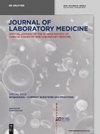高斯混合物建模如何帮助从病理值比例较高的实验室数据中验证参考区间
IF 1.8
4区 医学
Q4 MEDICAL LABORATORY TECHNOLOGY
引用次数: 0
摘要
目的 虽然有几种间接方法可用于验证参考限,但它们有一个共同的弱点,即假设病理值的比例较低。本文研究了高斯分解算法能否识别非病理部分,即使它不是混合数据的主要子集。方法 所有研究都在 R 编程环境中进行。mclust 软件包通过期望最大化(EM)算法用于高斯混合建模。对于右偏分布,则采用原始值的对数来近似高斯模型。我们使用贝叶斯信息准则(BIC)对结果进行评估。reflimR 和 refineR 软件包是比较程序。结果 我们生成了已知正态分布的合成数据混合物,以证明我们方法的可行性和可靠性。将该算法应用于尼日利亚和德国人口的真实数据,得出的结果有助于解释 reflimR 和 refineR 参考区间明显过宽的问题。在第一个例子中,对尼日利亚妇女血红蛋白的 mclust 分析支持了贫血率超过 50% 会导致参考区间过低的医学假设。我们的算法根据 BIC 值提出了多种方案,其中一种方案建议的参考限值接近尼日利亚的已公布数据,但明显低于为白种人制定的参考限值。在第二个例子中,对以心脏病为主的德国患者的肌酸激酶进行标准统计分析,得出的参考区间明显过宽。通过 mclust,我们找出了可以解释这一错误结果的重叠部分。结论 高斯混合物建模并不能取代参考区间估算的标准方法,但在这些方法产生不一致或难以置信的结果时,高斯混合物建模是一种有价值的辅助方法。本文章由计算机程序翻译,如有差异,请以英文原文为准。
How Gaussian mixture modelling can help to verify reference intervals from laboratory data with a high proportion of pathological values
Objectives Although there are several indirect methods that can be used to verify reference limits, they have a common weakness in that they assume a low proportion of pathological values. This paper investigates whether a Gaussian decomposition algorithm can identify the non-pathological fraction even if it is not the main subset of mixed data. Methods All investigations are carried out in the R programming environment. The mclust package is used for Gaussian mixture modelling via the expectation maximization (EM) algorithm. For right-skewed distributions, logarithms of the original values are taken to approximate the Gaussian model. We use the Bayesian information criterion (BIC) for evaluation of the results. The reflimR and refineR packages serve as comparison procedures. Results We generate synthetic data mixtures with known normal distributions to demonstrate the feasibility and reliability of our approach. Application of the algorithm to real data from a Nigerian and a German population produces results, which help to interpret reference intervals of reflimR and refineR that are obviously too wide. In the first example, the mclust analysis of hemoglobin in Nigerian women supports the medical hypothesis that an anemia rate of more than 50 % leads to falsely low reference limits. Our algorithm proposes various scenarios based on the BIC values, one of which suggests reference limits that are close to published data for Nigeria but significantly lower than those established for the Caucasian population. In the second example, the standard statistical analysis of creatine kinase in German patients with predominantly cardiac diseases yields a reference interval that is clearly too wide. With mclust we identify overlapping fractions that explain this false result. Conclusions Gaussian mixture modelling does not replace standard methods for reference interval estimation but is a valuable adjunct when these methods produce discrepant or implausible results.
求助全文
通过发布文献求助,成功后即可免费获取论文全文。
去求助
来源期刊

Journal of Laboratory Medicine
Mathematics-Discrete Mathematics and Combinatorics
CiteScore
2.50
自引率
0.00%
发文量
39
审稿时长
10 weeks
期刊介绍:
The Journal of Laboratory Medicine (JLM) is a bi-monthly published journal that reports on the latest developments in laboratory medicine. Particular focus is placed on the diagnostic aspects of the clinical laboratory, although technical, regulatory, and educational topics are equally covered. The Journal specializes in the publication of high-standard, competent and timely review articles on clinical, methodological and pathogenic aspects of modern laboratory diagnostics. These reviews are critically reviewed by expert reviewers and JLM’s Associate Editors who are specialists in the various subdisciplines of laboratory medicine. In addition, JLM publishes original research articles, case reports, point/counterpoint articles and letters to the editor, all of which are peer reviewed by at least two experts in the field.
 求助内容:
求助内容: 应助结果提醒方式:
应助结果提醒方式:


